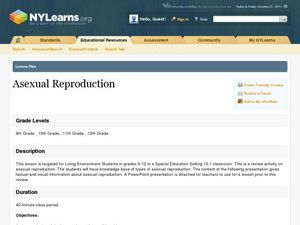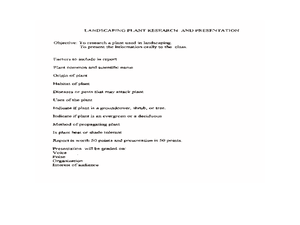Amoeba Sisters
Asexual and Sexual Reproduction
Why do some organisms reproduce sexually, others reproduce asexually, and some both? Biology scholars examine the pros and cons of sexual and asexual reproduction through a short, informative video. The resource offers great examples of...
Odell Education
Plant and Animal Cells
Incorporate multiple facets of the cell into your next high school lab! Through an introduction to cell organelles, class members observe each cell type and draw visuals to further demonstrate understanding of cellular processes in both...
Crash Course
The Sex Lives of Nonvascular Plants: Alternation of Generations
Plants evolved more than 400 million years ago into two types — vascular and nonvascular. Here's a video that explains the difference between vascular and nonvascular plants and then focuses on the over 24,000 types of nonvascular...
Curated OER
Pollination of Flowers by Moths
Turn your classroom into a pollination station as your kids transform into moths or predators trying to survive and aiding in plant reproduction along the way. Using silent party blowers as proboscises, the moths will have two minutes to...
PBS
Seasonal Science: Pine Pollen
More than 125 species of pine trees exist, and each species can live over 100 years, with some living over 1,000 years—that's a lot of pine pollen! The Seasonal Science series explains why pine trees produce pollen. The video details the...
Curated OER
Growing Up (And Around, and Down...) Exploring Plant Growth
Students build plant growing structures. In this plant growth lesson, students plant growth structures such as a garden tepee or a crawl through tunnel. They grow plants that are appropriate for the structure.
Curated OER
Flower Dissection
Beginning biologists pull a flower apart and familiarize themselves with the different reproductive structures. Why have them learn only from just a book or diagram when they can examine real samples? There is no link to the referenced...
Curated OER
Teacher's Plant Collection Guide
Young scholars explore a variety of guidelines that involve collecting plants in a responsible manner and participate in a plant pressing activity. For this teacher's plant collection guide lesson, students collect data regarding plants,...
PBS
How Sex Became a Thing
Birds, bees, flowers, trees ... and Funisia dorothea? Biology scholars journey back in time to discover more about the history of sexual reproduction. The video, one of many in a biology playlist, covers our earliest eukaryotic ancestor,...
Deep Look
This Vibrating Bumblebee Unlocks a Flower's Hidden Treasure
Some plants lock their pollen up until feeling the correct password. The video explains buzz pollination and how it differs from the pollination of other types of flowering plants. It lists multiple plants that require it and...
Alabama Wildlife Federation
Butterfly Gardening
Build a place for butterflies to call home. After identifying the needs of butterflies in terms of water, food, shelter, and reproduction, learners create a scale model of their ideal butterfly garden. Once the model is complete, they...
Curated OER
Asexual Reproduction
Sixth graders investigate how asexual reproduction produces single-parent offspring. They use plants and yeast to demonstrate vegetative propagation and budding in a laboratory. Students draw five different types of asexual reproduction.
Curated OER
Plants 1: Plant Parents
Students review their prior knowledge on plants. In groups, they compare and contrast the difference between reproducing asexually and sexually. Using the internet, they research how some plants can be forced to produce asexually.
Curated OER
Cell Study
Learners (females) are introduced to the cell. They discuss what a cell is, and students define what a cell is. Learners comprehend that all living things are made up of cells. They comprehend that life is defined as something that...
Garden Earth Naturalist Club
Parts of a Flower! Flower Dissection
Sometimes the best way to learn about plants is to see the different parts of a plant yourself. Groups of learners dissect flowers to answer questions about what they observe and what they wonder about their flower.
TED-Ed
The Sexual Deception of Orchids
A plant engaged in sexual deception? Strange but true. Believe it or not, orchids have developed a range of sexual adaptations that permit them to attract pollinators. The narrator of a short video describes a variety of strategies used...
Curated OER
Plants, Plants, and More Plants
Students examine several types of plants. In this plant lesson, students complete activities that require them to identify types of plants, chart plant anatomy, and explain plant propagation.
Curated OER
Plant And Animal Adaptations
Young scholars examine plant and animal life while looking at the environments the organismisms live in. They determine how form follows function by looking an aquatic turtle and noticing its feature of adaptation features. They work in...
Curated OER
The Chesapeake Bay in Captain John Smith's Time
When Captain John Smith visited the Chesapeake Bay in the summer of 1608, what types of animals and habitats did he encounter? Your young historians will analyze primary source documents to answer this question, as well as compare the...
Curated OER
Flower Power
Students explore the parts of flowers and how they reproduce. They dissect flowers and observe the reproductive organs. Students observe anthers and ovaries of Tiger Lilies under a microscope. They investigate how insects and other...
Curated OER
Making Community Measurements: Which Plant Part?
Students identify a plant in a given community and make a variety of measurements. They determine how a plant meets its basic needs. In addition to identifying plant parts, they observe seasonal change and compare plants within a community.
Curated OER
Plant Biotechnology: Controlling Tissue Differentiation
Students demonstrate hormonal control of plant tissue differentiation and relate this differentiation to gene expression. They explore the effects of hormones (auxin and cytokinin) on the genes that control tissue differentiation in callus.
Curated OER
Plant Biotechnology: Controlling Tissue Differentation
Students demonstrate skills of biotechnology stringent aseptic technique and statistical analysis. They describe hormonal control of plant tissue differentiation and relate this to gene expression. Students observe the effects of...
California Academy of Science
Why Protect Pollinators?
Would you rather having biting flies or chocolate? The question may seem absurd, but cocoa trees rely on pollination from biting flies. Viewers come to understand the importance of pollinators to our food supply, flowers, and entire...

























